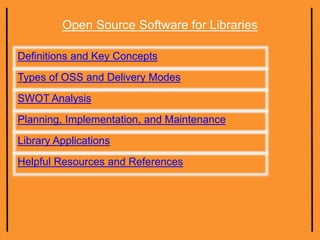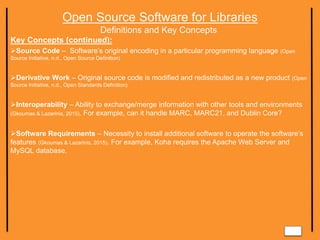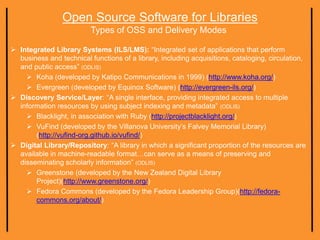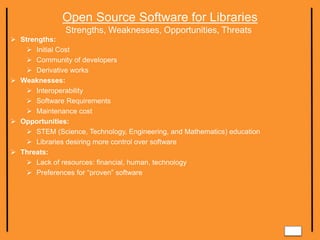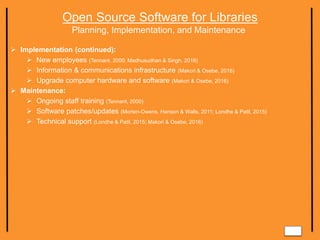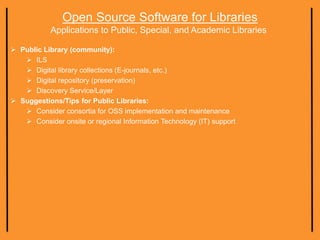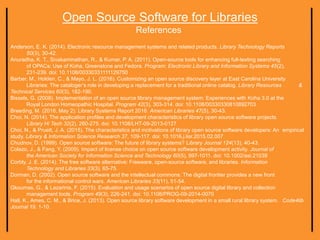INSC580MacasaOpenSourceSoftwareLibrariesFall2016
- 1. Open Source Software for Libraries Presented by Michael Macasa INSC 580 November 16, 2016
- 2. Open Source Software for Libraries Definitions and Key Concepts Types of OSS and Delivery Modes SWOT Analysis Planning, Implementation, and Maintenance Library Applications Helpful Resources and References
- 3. Open Source Software for Libraries Definitions and Key Concepts Defined: Library software whose source code is available to programmers who want to modify/improve the software, and permits the redistribution of “copies of either the original or modified program without having to pay royalties to previous developers” (Macan, Fernandez & Stojanovski, 2013, p. 138) Key Concepts: Software License – Legal regulation to regulate scope of use, redistribution, warranty, and attribution of software products, requiring that the source code be made publicly available and allows modification and redistribution (Colazo & Fang, 2009) GNU General Public License (GPL) (“viral”) – Rededistribution with derivative works must be licensed with the GPL, not a commercial software license (Parsons, 2016; Colazo & Fang, 2009) Berkeley Software Distribution License (BSD) – Redistribution and use permitted under certain conditions (Parsons, 2016); source code is made public, later modified and redistributed under proprietary licenses without “copyleft” (Colazo & Fang, 2009) “Copyleft” Clause – Any modification to original source code must be released/redistributed under the same terms under which it was acquired (Colazo & Fang, 2009)
- 4. Open Source Software for Libraries Definitions and Key Concepts Key Concepts (continued): Source Code – Software’s original encoding in a particular programming language (Open Source Initiative, n.d., Open Source Definition) Derivative Work – Original source code is modified and redistributed as a new product (Open Source Initiative, n.d., Open Standards Definition) Interoperability – Ability to exchange/merge information with other tools and environments (Gkoumas & Lazarinis, 2015). For example, can it handle MARC, MARC21, and Dublin Core? Software Requirements – Necessity to install additional software to operate the software’s features (Gkoumas & Lazarinis, 2015). For example, Koha requires the Apache Web Server and MySQL database.
- 5. Open Source Software for Libraries Types of OSS and Delivery Modes Integrated Library Systems (ILS/LMS): “Integrated set of applications that perform business and technical functions of a library, including acquisitions, cataloging, circulation, and public access” (ODLIS) Koha (developed by Katipo Communications in 1999) (http://www.koha.org/) Evergreen (developed by Equinox Software) (http://evergreen-ils.org/) Discovery Service/Layer: “A single interface, providing integrated access to multiple information resources by using subject indexing and metadata” (ODLIS) Blacklight, in association with Ruby (http://projectblacklight.org/) VuFind (developed by the Villanova University’s Falvey Memorial Library) (http://vufind-org.github.io/vufind/) Digital Library/Repository: “A library in which a significant proportion of the resources are available in machine-readable format…can serve as a means of preserving and disseminating scholarly information” (ODLIS) Greenstone (developed by the New Zealand Digital Library Project)(http://www.greenstone.org/) Fedora Commons (developed by the Fedora Leadership Group)(http://fedora- commons.org/about/)
- 6. Open Source Software for Libraries Types of OSS and Delivery Modes Email Hypermail (http://www.hypermail-project.org/) Web-Browsing: SWISH-E (Simple Web Indexing System for Humans-Enhanced) (http://www.searchtools.com/tools/swish.html) Firefox (https://www.mozilla.org/en-US/firefox/new/?scene=2) Databases: MySQL (http://www.mysql.com/) Operating Systems: Linux (http://www.linux.org/) Ubuntu (https://www.ubuntu.com/) Electronic Resource Management (ERM): “Developed to assist librarians in the control of licensed third-party resources published electronically” (ODLIS) Coral (developed by Notre Dame) (http://coral-erm.org/) CUFTS (developed by Simon Frasier University) (http://lib- code.lib.sfu.ca/projects/CUFTS/)
- 7. Open Source Software for Libraries Strengths, Weaknesses, Opportunities, Threats Strengths: Initial Cost Community of developers Derivative works Weaknesses: Interoperability Software Requirements Maintenance cost Opportunities: STEM (Science, Technology, Engineering, and Mathematics) education Libraries desiring more control over software Threats: Lack of resources: financial, human, technology Preferences for “proven” software
- 8. Open Source Software for Libraries Planning, Implementation, and Maintenance Planning: Meetings, meetings, meetings! (Singh, 2014) Consider library size (collection, resources, users, etc.) (Tennant, 2000; Gkoumas & Lazarinis, 2015) Consider hardware and software changes (Makori & Osebe, 2016) Consider current staff (Tennant, 2000) Consider the readiness of the parent organization (Makori & Osebe, 2016) Determine core functions (Bissels, 2008; Kamble, Raj & Sangeeta, 2012; Macan, Fernandez & Stojanovski, 2013) Implementation: Project leadership must understand the library’s vision (Makori & Osebe, 2016) Customized training for users/administrators (Tennant, 2000; Morten-Owens, Hanson & Walls, 2011; Makori & Osebe, 2016) Data migration, conversion, and upload (Thompson, 2012); Makori & Osebe, 2016) Configuration (web pages, modules, layers) (Morten-Owens, Hanson & Walls, 2011)
- 9. Open Source Software for Libraries Planning, Implementation, and Maintenance Implementation (continued): New employees (Tennant, 2000; Madhusudhan & Singh, 2016) Information & communications infrastructure (Makori & Osebe, 2016) Upgrade computer hardware and software (Makori & Osebe, 2016) Maintenance: Ongoing staff training (Tennant, 2000) Software patches/updates (Morten-Owens, Hanson & Walls, 2011; Londhe & Patil, 2015) Technical support (Londhe & Patil, 2015; Makori & Osebe, 2016)
- 10. Open Source Software for Libraries Applications to Public, Special, and Academic Libraries Public Library (community): ILS Digital library collections (E-journals, etc.) Digital repository (preservation) Discovery Service/Layer Suggestions/Tips for Public Libraries: Consider consortia for OSS implementation and maintenance Consider onsite or regional Information Technology (IT) support
- 11. Open Source Software for Libraries Applications to Public, Special, and Academic Libraries Special Library (law firm, corporation, etc.): Digital library collection (E-journals, etc.) Discovery Service/Layer E-publishing Academic Library (university, college): ILS Digital library collections (E-journals, etc.) Digital repository (preservation, faculty scholarship) Geospatial data processing E-publishing Suggestions and Tips for Special Libraries and Academic Libraries Hire staff to install/maintain the software (if needed) (Tennant, 2000) Have a project leader who understands and communicates the library’s vision
- 12. Open Source Software for Libraries Helpful Resources Suggestions and Tips for any Library: Staff need to be trained and believe that the OSS is a solution (Misra, 2011) Read the software licensing agreement: Does it fit with the library’s use of the software? (Muller, 2011; Morton-Owens, Hanson & Walls, 2011) Evaluate the sustainability of the OSS provider (Muller, 2011) Match the OSS with the needs of the library and its users (Muller, 2011)
- 13. Open Source Software for Libraries References Anderson, E. K. (2014). Electronic resource management systems and related products. Library Technology Reports 50(3), 30-42. Anuradha, K. T., Sivakaminathan, R., & Kumar, P. A. (2011). Open-source tools for enhancing full-texting searching of OPACs: Use of Koha, Greenstone and Fedora. Program: Electronic Library and Information Systems 45(2), 231-239. doi: 10.1108/00330331111129750 Barber, M., Holden, C., & Mayo, J. L. (2016). Customizing an open source discovery layer at East Carolina University Libraries: The cataloger’s role in developing a replacement for a traditional online catalog. Library Resources & Technical Services 60(3), 182-190. Bissels, G. (2008). Implementation of an open source library management system: Experiences with Koha 3.0 at the Royal London Homeopathic Hospital. Program 42(3), 303-314. doi: 10.1108/00330330810892703 Breeding, M. (2016, May 2). Library Systems Report 2016. American Libraries 47(5), 30-43. Choi, N. (2014). The application profiles and development characteristics of library open source software projects. Library Hi Tech 32(2), 260-275. doi: 10.1108/LHT-09-2013-0127 Choi, N., & Pruett, J. A. (2015). The characteristics and motivations of library open source software developers: An empirical study. Library & Information Science Research 37, 109-117. doi: 10.1016.j.lisr.2015.02.007 Chudnov, D. (1999). Open source software: The future of library systems? Library Journal 124(13), 40-43. Colazo, J., & Fang, Y. (2009). Impact of license choice on open source software development activity. Journal of the American Society for Information Science and Technology 60(5), 997-1011. doi: 10.1002/asi.21039 Corbly, J. E. (2014). The free software alternative: Freeware, open-source software, and libraries. Information Technology and Libraries 33(3), 65-75. Dorman, D. (2002). Open source software and the intellectual commons: The digital frontier provides a new front for the informational control wars. American Libraries 33(11), 51-54. Gkoumas, G., & Lazarinis, F. (2015). Evaluation and usage scenarios of open source digital library and collection management tools. Program 49(3), 226-241. doi: 10.1108/PROG-09-2014-0070 Hall, K., Ames, C. M., & Brice, J. (2013). Open source library software development in a small rural library system. Code4lib Journal 19, 1-10.
- 14. Open Source Software for Libraries References Kamble, V. T., Ran, H., & Sangeeta. (2012). Open source library management and digital library software. DESIDOC Journal of Library & Information Technology 32(5), 388-392. Kaplan, D. (2009). Choosing a digital asset management system that’s right for you. Journal of Archival Organization 7, 33-40. doi: 10/1080/15332740902897360 Londhe, N. L., & Patil, S. K. (2015). Success and abandonment of OSS library management systems. DESIDOC Journal of Library & Information Technology 35(6), 398-407. Macan, B., Fernandez, G. V., & Stojanovski, J. (2013). Open source solutions for libraries: ABCD vs Koha. Program 47(2), 136-154. doi: 10/1108/00330331311313726 Makori, E. O., & Osebe, N. M. (2016). Koha enterprise resource planning system and its potential impact on information management organizations. Library Hi Tech News 33(4), 17-23. doi: 10.1108/LHTN-01-2016- 0005 Madhusudahn, M., & Singh, V. (2016). Integrated library management systems: Comparative analysis of Koha, Libsys, NewGenLib, and Virtua. The Electronic Library 34(2), 223-249. doi: 10.1108/EL-08-2014- 0127 Misra, I., Moorthi, S., Gambhir, R. K., & Ramakrishnan, R. (2011). Evolutionary rapid development using open source framework for geospatial data processing. Trends in Information Management 7(1), 31-40. Molyneux, R. E. (2011). An open source ILS glossary: Version 2. Public Library Quarterly 30, 165-176. doi: 10.1080/01616846.2011.578054 Morten-Owens, E. G., Hanson, K. L., & Walls, I. (2011). Implementing open-source software for three core library functions: A stage-by-stage comparison. Journal of Electronic Resources in Medical Libraries 8(1), 1-14. doi: 10/1080/15424065.2011.551486 Muller, T. (2011). How to choose a free and open source integrated library system. OCLC Systems & Services: International Digital Library Perspectives 27(1), 57-78. doi: 10.1108/1065075111116573 Open Source Intiative. (n.d.). Open Source Definition (Annotated). Retrieved from https://opensource.org/osd.html. Open Source Initiative. (n.d.). Open Standards Requirement for Software. Retrieved from https://opensource.org/osr.
- 15. Open Source Software for Libraries References Palmer, A., & Choi, N. (2014). The current state of library open source software research. Library Hi Tech 32(1), 11-27. doi: 10.1108/LHT-05-2013-0056 Parsons, J. J. (2016). New Perspectives on Computer Concepts, 2016, Introductory. Boston, MA: Cengage Learning. Samuels, R. G., & Griffy, H. (2012). Evaluating open source software for use in library initiatives: A case study involving electronic publishing. portal: Libraries and the Academy 12(1), 41-62. doi: 10.1353/pla.2012.0007 Sarma, G. K. (2016). OPAC module in open source library management software: A comparative study. DESICOC Journal of Library & Information Technology 36(1), 56-61. doi: 10.14429/djlit.36.1.9223 Singh, M., & Sanaman, G. (2012). Open source integrated library management systems. The Electronic Library 30(6), 809-832. doi: 10/1108/02640471211282127 Singh, V. (2014). A case study of migration to an open source ILS: Partnership among state libraries. Qualitative and Quantitative Methods in Libraries (QQML), Special Issue 2014, 59-68. Tennant, R. (2000). The role of open source software. Library Journal 125(1), 36. Thompson, K. J. (2012). Free as in freedom, not as in beer: Free and open source software ILS and the library community. B Sides, 1-17.
- 16. Open Source Software for Libraries Presented by Michael Macasa INSC 580 November 16, 2016

